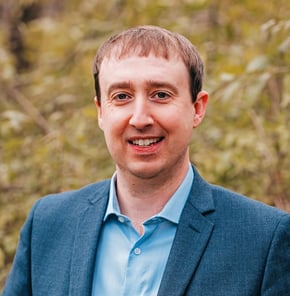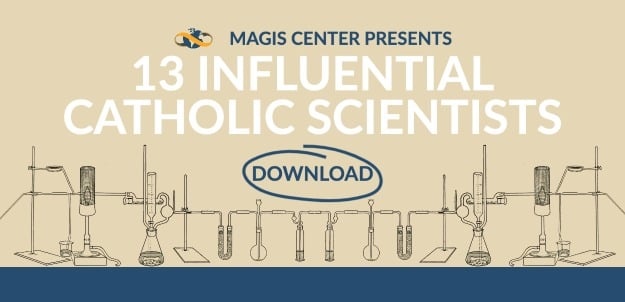In part 1, we reviewed the historical relationship between the Church and science, learned about Guglielmo Marconi’s connection to the papacy, and examined Georges Lemaître’s collaboration with Albert Einstein. In this part, we will meet several more Nobel collaborators and conclude with a vision for the future.
Catholic Nobel Laureate Victor Hess and His Collaborators
Victor Hess (1883–1964) was an Austrian physicist who shared the 1936 Nobel Prize in Physics for his discovery of cosmic rays. He also researched radioactive fallout and the effects of radiation on the human body.1 Hess served as a professor of physics at Fordham University, where he collaborated with several priest-scientists. He was also a practicing Catholic who wrote an article called “My Faith” to explain his belief in God.
Hess’s cosmic ray research was partly inspired by Theodor Wulf (1868–1946), a German Jesuit priest and physicist. Wulf studied physics under Walther Nerst, recipient of the 1920 Nobel Prize in Chemistry. Wulf designed an electrometer to measure ionizing radiation at the Earth’s surface and at the top of the Eiffel Tower. He published his findings in 1910 with an article on “Observations of the radiation of high-penetration capacity on the Eiffel Tower.”2 Although his findings were affected by the Tower’s radioactivity, Wulf’s research helped inspire Hess’s work.
Stanley Jaki (1924–2009) was a Hungarian Benedictine priest who served as a professor at Seton Hall University. He earned a Ph.D. in physics under Hess with a dissertation on “A Study of the Distribution of Radon, Thoron, and Their Decay Products Above and Below the Ground.” Jaki authored numerous works on the importance of the Catholic faith for the development of science, including The Savior of Science, Science and Creation: From Eternal Cycles to an Oscillating Universe, and The Road of Science and the Ways to God. In recognition of his achievements, he received the Templeton Prize in 1987 for “bridging the gap between science and religion.”
The Jesuit priest, J. Donald Roll (1912–1986) studied under Hess at Fordham and earned his doctorate with “A Study of the Natural and Induced Radioactivity of Rocks.” Roll and Hess also co-authored papers for The Physical Review. Roll served as chair of the physics department at Loyola University Chicago and directed the university’s seismological station.3
Francisco X. Roser, a Jesuit Austrian scientist who worked mostly in Brazil, earned a doctorate under Hess with a dissertation on cosmic rays. Roser completed postdoctoral studies at Oak Ridge, Chicago, Stanford, and Fordham and researched cosmic radiation, nuclear magnetic resonance, and radioactive contamination. Roser also studied under or worked with the Nobel laureates Enrico Fermi (Physics, 1938), Willis Lamb (Physics, 1955), Robert Hofstadter (Physics, 1961), Felix Bloch (Physics, 1952), and Richard Feynman (Physics, 1965).4
Jean-Baptiste Senderens and Nobel Laureate Paul Sabatier
Jean-Baptiste Senderens (1856–1937) was a French priest who made pioneering contributions to catalytic chemistry. He maintained a long-time collaboration with Paul Sabatier, who shared the 1912 Nobel Prize in Chemistry. They co-developed the Sabatier-Senderens Process, a contribution that led to them jointly being awarded the Prix Jecker in 1905. They also co-authored dozens of scientific papers. In his 1912 Nobel lecture, Sabatier mentioned Senderens six times.5
Mario Camis and Nobel Laureate Charles Scott Sherrington
Mario Camis (1878–1946) was a Dominican priest and a convert to Catholicism from Judaism. Considered one of the most noteworthy Italian physiologists of his time, he discovered the phenomenon of occlusion in the spinal reflex, researched the relationship between the vestibular system and vasomotor reflexes, and studied the link between hemoglobin and oxygen. He studied under Charles Scott Sherrington, recipient of the 1932 Nobel Prize in Physiology or Medicine. When Camis died, two books were displayed next to him in the mortuary chapel: the Bible and Sherrington’s The Integrative Action of the Nervous System.6
Frans Alfons Janssens and Nobel Laureate Thomas Hunt Morgan
Frans Alfons Janssens (1863–1924) was a Belgian priest and canon at the Sint-Baafskathedraal in Ghent. A prominent cytologist who served as president of the Société Belge de Biologie, he researched mollusks, water salamanders, yeast, fungi, frogs, and toads. Importantly, he discovered the crossing over of genes during meiosis. Janssens’ work was built on by Thomas Hunt Morgan, 1933 Nobel laureate in Physiology or Medicine. In 1925, Morgan wrote: “The evidence for crossing-over in Amphibia and in Orthoptera that Janssens has brought forward is of great importance for genetics and for cytology.”7 Like numerous other twentieth-century and contemporary biologists and geneticists, Morgan was also influenced by the work of the Augustinian priest Gregor Mendel, as shown in Morgan’s work The Mechanism of Mendelian Heredity.
Zacarías Martínez Núñez and Nobel Laureate Santiago Ramón y Cajal
Zacarías Martínez Núñez (1864–1933) was a Spanish Augustinian priest and biologist who was later appointed Archbishop of Santiago de Compostela. Martínez Núñez maintained a long-time friendship and correspondence with Santiago Ramón y Cajal, recipient of the 1906 Nobel Prize in Physiology or Medicine. In 1907, Martínez Núñez published a work on sleep, with a foreword by Ramón y Cajal.8
Mijo Bobetić and Nobel Laureate John Bardeen
The Croatian Franciscan priest Mijo Bobetić (1921–1998) served as assistant to John Bardeen at the University of Illinois. Bardeen was a two-time Nobel Laureate in Physics (1956 and 1972). Bobetić researched ultrasound absorption by superconductors and wrote his dissertation on “Interatomic forces and the properties of crystalline inert gases: Argon, Krypton.”9
Beyond the Conflict Thesis: A Vision for the Future
This survey of dialogue and integration provides strong evidence against the conflict thesis. But is a largely nineteenth-century polemical worldview the appropriate measure of the Church’s scientific accomplishments? Is it enough to say there is no conflict between faith and science? In other human endeavors, Catholics have set a lofty bar. For instance, we do not talk about a conflict in the same terms when discussing the Church and education, the Church and music, or the Church and charitable work, to name a few areas of engagement. When viewing the Church’s historical contributions in these fields, Catholics have pursued the highest excellence.
Considering its metaphysical, institutional, and personal assets, including organizations like the Society of Catholic Scientists,10 the Church has the horsepower to reorient its gaze to even higher scientific achievement. The Catholic Church, with its divine foundation in Christ, believes that God is the creator of “all things visible and invisible” and the author of truth. Illumined by this full picture of reality, Catholics have opportunities to excel in those areas that are True, Good, and Beautiful. Thus, in the scientific realm, a key component in overcoming the conflict model is Catholic overachievement in the sciences at the highest levels: Nobel Prizes, Wolf Prizes, Fields Medals, Abel Prizes, chairs of scientific departments, etc.
In 1988, Pope St. John Paul II wrote a letter to Fr. George Coyne, S.J., then director of the Vatican Observatory. In the words of the Holy Father: “Science can purify religion from error and superstition; religion can purify science from idolatry and false absolutes. Each can draw the other into a wider world, a world in which both can flourish.”11 Catholic scientific overachievement would build up both the Church and science, provide a witness to the world, and, fulfilling a vision of Alfred Nobel, confer “the greatest benefit to humankind.”12
Footnotes:
1 “Hess, Victor Francis,” Current Biography Yearbook 1963, https://www.mpi-hd.mpg.de/hfm/HESS/public/hessbio.html.
2 “September 15, 1910: Theodor Wulf Publishes First Evidence of Cosmic Radiation,” APSNews 28, no. 8, August/September 2019, https://www.aps.org/publications/apsnews/201908/history.cfm.
3 “J. Donald Roll, S.J. Papers,” Loyola University Chicago, accessed September 30, 2023, https://www.luc.edu/media/lucedu/archives/pdfs/roll_sj_papers.pdf.
4 “Francisco X. Roser, S.J., Noted Brazilian Physicist,” Physics Today 20, no. 6 (1967): 105, https://pubs.aip.org/physicstoday/article/20/6/105/425798/Francisco-X-Roser-S-J-Noted-Brazilian-Physicist.
5 Paul Sabatier, “Nobel Lecture,” December 11, 1912, https://www.nobelprize.org/prizes/chemistry/1912/sabatier/lecture/.
6 Diana Troiani and Ermanno Manni, “A tribute to Italian physiologists of Jewish descent evicted during the persecution ordered by the Fascist Regime in 1938,” Advances in Physiological Education 31, (June 2007): 123-128, https://www.physiology.org/doi/pdf/10.1152/advan.00059.2006.
7 Romain Koszul, Matthew Meselson, Karine Van Doninck, Jean Vandenhaute, and Denise Zickler, “The Centenary of Janssens’s Chiasmatype Theory,” Genetics 191, no. 2, (June 2012): 309–317, https://www.ncbi.nlm.nih.gov/pmc/articles/PMC3374303/.
8 Virgilio Ibarz Serrat, “La Correspondencia entre Ramón y Cajal y Zacarías Martínez (1864-1933),” Psychologia Latina 3, no. 2 (2012): 76-83, https://psicologia.ucm.es/data/cont/docs/29-2013-04-25-art29.pdf.
9 Anđelka Stipčević-Despotović, “BOBETIĆ, Mijo Vitomir,” Hrvatski Biografski Leksikon, 1989, https://bl.lzmk.hr/Clanak/2166.
10 See https://catholicscientists.org/
11 “Letter of His Holiness John Paul II to Reverend George V. Coyne, S.J. Director of the Vatican Observatory,” June 1, 1988, https://www.vatican.va/content/john-paul-ii/en/letters/1988/documents/hf_jp-ii_let_19880601_padre-coyne.html.
12 “Full text of Alfred Nobel’s will,” The Nobel Prize, https://www.nobelprize.org/alfred-nobel/full-text-of-alfred-nobels-will-2/.
Cover image: Adam Baker, CC BY 2.0, via Wikimedia Commons


